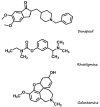Honeys as Possible Sources of Cholinesterase Inhibitors
- PMID: 35889933
- PMCID: PMC9319579
- DOI: 10.3390/nu14142969
Honeys as Possible Sources of Cholinesterase Inhibitors
Abstract
Alzheimer's disease (AD) is a progressive neurodegenerative disease characterised by low levels of the neurotransmitter (acetylcholine), oxidative stress, and inflammation of the central nervous system. The only currently available form of treatment entails the administration of AChE/BChE (acetylcholinesterase/butyrylcholinesterase) inhibitors to patients diagnosed with the disease. However, AD prevention is possible by administering the correct inhibitors with food. The aim of this study was to examine 19 types of honey in terms of their contents of cholinesterase inhibitors. The inhibition of AChE and BChE relative to the respective honey samples was evaluated using Ellman's colorimetric method, including the "false-positive" effect. The highest potential for AChE inhibition was observed in the case of thyme honey (21.17% inhibition), while goldenrod honey showed the highest capacity for BChE inhibition (33.89%). Our study showed that honeys may provide a rich source of cholinesterase inhibitors and, in this way, play a significant role in AD.
Keywords: AChE; Alzheimer’s disease; BChE; acetylcholine; honey.
Conflict of interest statement
The authors declare no conflict of interest.
Figures




References
-
- Alzheimer’s Association Alzheimer’s disease facts and figures. Alzheimers Dement. 2019;15:321–387.
-
- Prince M., Bryce R., Ferri C. Alzheimer’s Disease International World Alzheimer Report 2011. The Benefits of Early Diagnosis and Intervention. Alz-heimer’s Disease International. 2011. [(accessed on 25 May 2022)]. Available online: https://www.alz.co.uk/research/WorldAlzheimerReport2011.pdf.
-
- Langyanai S., Chaniad P., Puripattanavong J. Acetylcholinesterase Inhibitory and Antioxidant Properties of Thai Vegetables. Int. J. Pharm. Med. Biol. Sci. 2017;6:67–72. doi: 10.18178/ijpmbs.6.2.67-72. - DOI
-
- Zhao T., Ding K., Zhang L., Cheng X., Wang C., Wang Z. Acetylcholinesterase and Butyrylcholinesterase inhibitory activities of ß-carboline and quinoline alkaloids derivatives from the plants of genus peganum. J. Chem. 2013;2013:717232. doi: 10.1155/2013/717232. - DOI
MeSH terms
Substances
LinkOut - more resources
Full Text Sources
Medical
Miscellaneous

